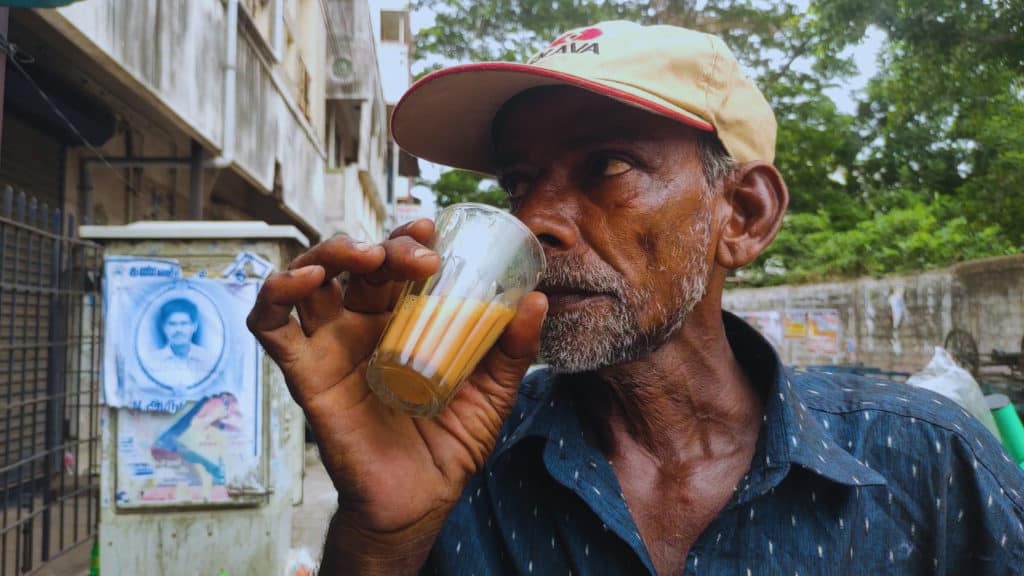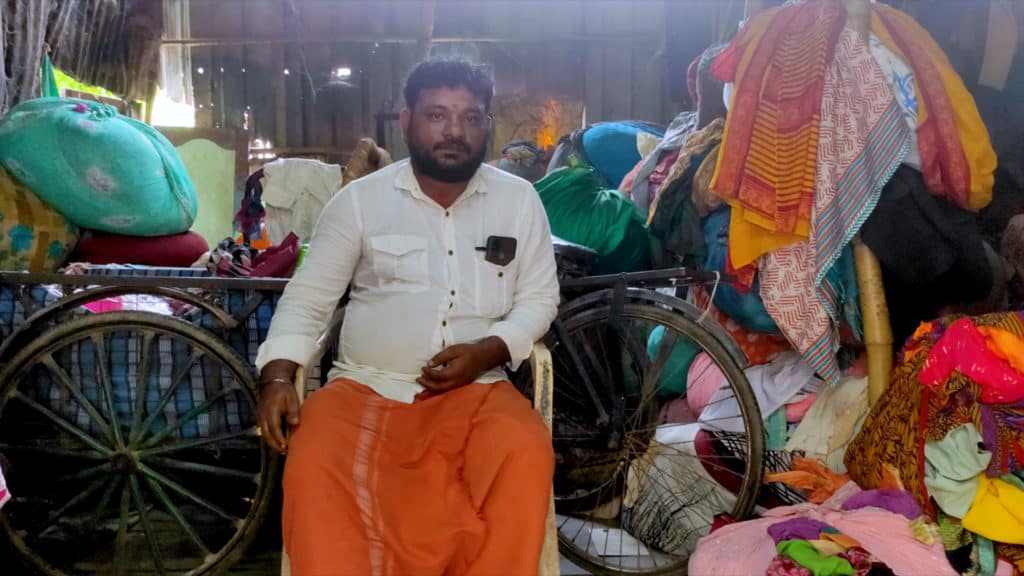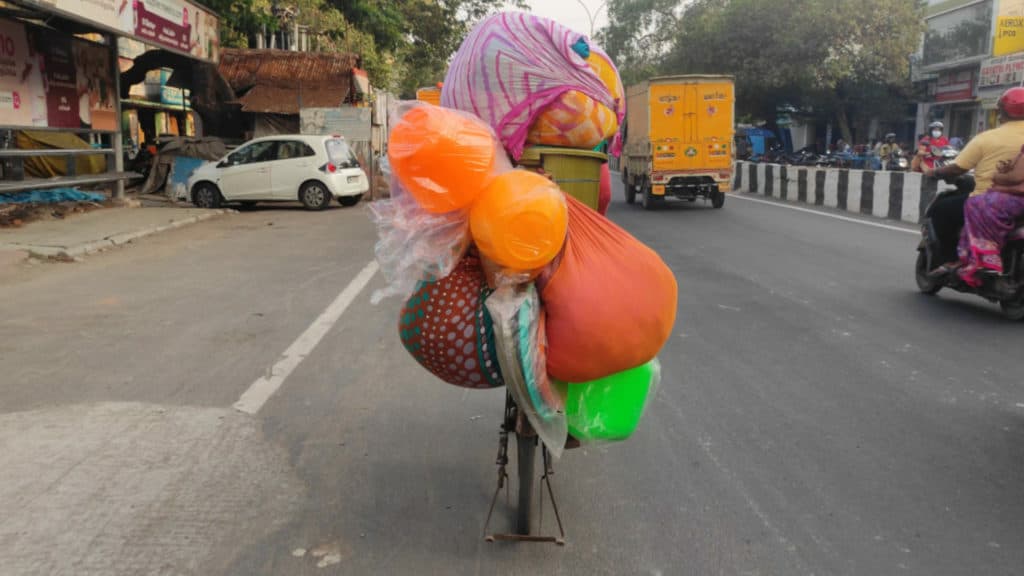A cycle and a loudspeaker accompany Ladoo as he makes his way around Chennai’s neighbourhoods, gathering old clothes. He turns off his loudspeaker around certain homes. “They don’t like the noise”, he explains to me, as I stop him for a chat. Laddo has been in this business for twenty-five years now. “In all this time, people have not changed”, he tells me philosophically. “Only my cycle and loudspeaker have”.
“They know me by my hat”, he says. “You can ask anyone for the ‘bhai’ with a hat”.
I ask him why the name ‘Ladoo’? “I was a chubby child,” he says, laughing. His real name is Karim. He lives in Pulianthope but goes all around the city, picking up castaway clothes, in exchange for aluminium kitchenware and plastic goods.
I have been told that there are as many as 20,000 waste collectors, like Karim, around the city. This figure also includes the women who work in this trade. While men typically ride cycles and motorbikes to get around, women go on foot, with their wares carried in a bundle on their heads. They sell the clothes they collect to aggregators; and live off the money they make like this.
You could liken these aggregators to employers. They even help out the waste collectors when the business is not good. In Chennai, aggregators are mostly concentrated around Pulianthope, Vyasarpadi, Erukkancherry, Kannappar Thidal and Pallavaram.
Conspicuous consumption leads to many discarded clothes
We know that man has been a fully clothed being for some centuries now. While geographical and climatic conditions played a major role in how early humans dressed, it is now our burgeoning economies that influence how we dress.
We feast with our eyes on a veritable fashion parade – as these are presented to us through movies, advertisements and social media. Add to this the lure of discounts and the massive shopping malls! While we used to shop for clothes on birthdays, festivals and such, we now shop for apparently no reason, except that we can afford to buy. We buy and cast away. Very often, what we buy does not last more than a season.
My colleague was talking about how his family used ‘hand-me-downs’ – clothes that get passed from the oldest in the family to the youngest. Why has this changed?
I can think of three reasons why: 1) how affordable fashion has become 2) how short the life of these clothes are 3) how comfortable people are with the ‘use and throw’ culture. This is what we call ‘fast fashion’.
So ‘fast’ is this fashion, that on average Indians discard as many as 10 lakh tonnes of fabric waste every year. Much of this is simply burnt in landfills. Just the vast amount of clothes that are being produced and discarded has now placed fashion as one of the top polluting industries in the world.
Tamil Nadu has sacrificed several kilometres of waterways for this dubious achievement. Manufacturing one pair of jeans needs as much as 3781 litres of water. While we walk around dressed like butterflies, someone, somewhere around the world is walking kilometres in search of water.
Read more: Can Chennai ever become a bin-less city?
Recycling economy for old clothes in Chennai
I next speak to Hyath Bhai, who is an aggregator. He explains the trade in a bit more detail.
‘‘Waste collectors come to me first thing in the morning. They collect some aluminium pots and pans and some plastic goods to barter with. They set off around 10, walking around the city, calling out ‘Old clothes! Old Clothes!’ Some people want money in exchange for their clothes. Others want aluminium or plastic wares. There will be a bit of haggling in the process. At the end of the day, we get old clothes for the value of aluminium and plastic wares collected in the morning”, he says.
“Clothes that exceed this amount are paid for in cash. This could be 300 to 400 rupees; sometimes more, sometimes less. We take Tuesdays and Fridays off. My father was in this same business. I also used to be a waste collector, travelling through neighbourhoods. I am now here after the hard work of all those years. Ours is a difficult job; we are dealing with waste. We have our overheads – the rent, electricity bills, salaries etc. Can you believe that we also pay 5% GST on this! Additionally, I recently came to know that the Chennai Corporation plans to add a Service Tax to our already strained finances”, he says.
“So what happens next to the old clothes that make it this far?” I ask him.
“We segregate it – by fabric type, quality and wear and tear. We then make neat bundles of each of these and sell them on. Some that can be salvaged, are taken to be washed well, repaired and sold in the second-hand market. While the rich buy in showrooms for thousands of rupees, the poor labourer and the daily wage earner, will buy these for a couple of hundred rupees”, says Hyath.
I also chat with Senthil anna, who runs a godown for cloth waste. “My dad’s been in this business for over forty years now. My extended family also works in this business. We understand it well. Every piece of fabric that comes to us finds another lease of life. Some of these fabrics are used to make rope. Some are bought in bulk by large businesses to be used as dusting rags. Some are used to make doormats. They are used in Kolkata for storing betel leaves – damp fabric keeps the leaves fresh and tender. I get 2000 kilos of fabric here a week – none of this goes to waste”, he explains.
Karim offers an essential service
“I am sixty now, and I’ve slowed down over the years. I don’t travel as much as I used to. And it’s not just my physical health that’s taken a setback. I got my kids married and settled using my income from this business. But everything is so much more expensive now. Our aluminium wares cost more. Our household expenses are higher. While earlier, three or four transactions throughout the day were enough to meet our needs, we’re left struggling even after ten transactions these days. If we didn’t pick up these clothes, they would be littering our streets and waterways. I can’t believe that the system for just collecting waste can be rife with so many obstacles!”, laments Karim.
I understand what he means. People like Karim offer an essential service. If it was not for them, our landfills would be taller, and our water and air more toxic. Waste workers remain an informal sector and their incredible contributions to society go unnoticed. What we need are policies that acknowledge the work of people like Karim, and make their life easier.
They need to be formalized by the government, receiving the benefits that any formal worker would receive. Obstacles such as taxes that deter this essential service should be withdrawn. Policies should also include the creation of EPR (Extended Producer Responsibility) that will place waste collectors at the heart of waste management – from collection and segregation to recycling of products.
Read more: Chennai waste pickers stare at uncertain future in the face of source segregation
What manufacturers and shoppers must realise
We need more accountability from manufacturers. We need them to acknowledge their role in the pollution and resulting climate crisis; and robust policies that will keep manufacturing within sustainable and responsible limits. Companies need to stop selling us false solutions such as fabric made from PET bottles. While they paint rosy pictures of their green credentials, what waste workers and the world actually need are real efforts towards sustainable production which will in turn encourage sustainable consumption.
Our ‘civilized’ ways allow us to leave an heirloom of waste for future generations. We can already see the consequences of our habit of extreme consumption. The only way out is to buy only what we need – not everything we want, and everything we see.
While this will help to reduce how much waste we generate, any waste that is inevitably produced must be entrusted to people like Karim. While society still fails to acknowledge our waste warriors, maybe you can now see why we need Karim?
[This story was first published on the blogs of Citizen Consumer and Civic Action Group and has been republished with permission. The original post can be found here.]


